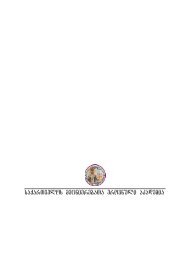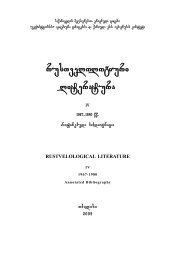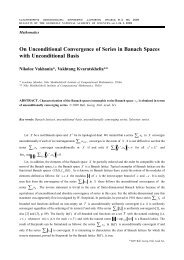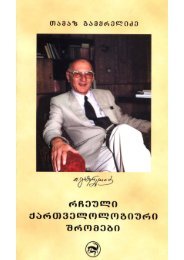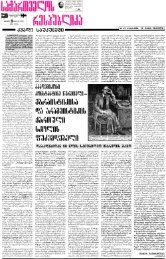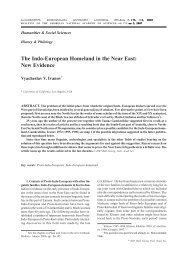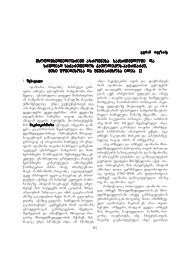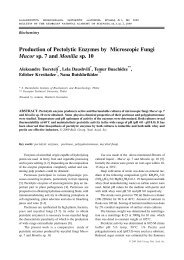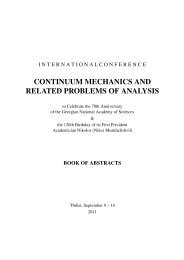Recent Trends in Nostratic Comparative Linguistics - The Georgian ...
Recent Trends in Nostratic Comparative Linguistics - The Georgian ...
Recent Trends in Nostratic Comparative Linguistics - The Georgian ...
Create successful ePaper yourself
Turn your PDF publications into a flip-book with our unique Google optimized e-Paper software.
<strong>Recent</strong> <strong>Trends</strong> <strong>in</strong> <strong>Nostratic</strong> <strong>Comparative</strong> L<strong>in</strong>guistics 155<br />
Plural/collective: *-la<br />
Plural: *-nV<br />
Note: plurality could also be expressed by reduplication of the root.<br />
7.3. Derivational Suffixes<br />
Nom<strong>in</strong>alizer: *-ri/*-re<br />
Nom<strong>in</strong>alizer: *-ma<br />
Nom<strong>in</strong>alizer: *-ya<br />
Nom<strong>in</strong>alizer: *-t h a<br />
Nom<strong>in</strong>alizer: *-na<br />
Nom<strong>in</strong>alizer: *-la<br />
Nom<strong>in</strong>alizer: *-k h a<br />
Nom<strong>in</strong>alizer: *-k’a<br />
8.0. Verbal Morphology<br />
In Proto-<strong>Nostratic</strong>, verbs fell <strong>in</strong>to two types of construction: (1) active and (2) stative. In active constructions,<br />
which usually <strong>in</strong>volved transitive verbs, the grammatical subject of the verb represented the agent perform<strong>in</strong>g the<br />
action, and the direct object represented the patient, or recipient, of the action. Stative constructions, on the other<br />
hand, expressed a state of affairs, rather than an event. Verbs expressed aspectual contrasts rather than temporal<br />
contrasts. Tense relates the time of the situation referred to to some other time, usually to the moment of speak<strong>in</strong>g,<br />
while aspect marks the duration or type of temporal activity denoted by the verb. Proto-<strong>Nostratic</strong> had two aspects: (A)<br />
perfective (past) and (B) imperfective (non-past). Proto-<strong>Nostratic</strong> also had, at the very least, the follow<strong>in</strong>g moods:<br />
(A) <strong>in</strong>dicative; (B) imperative; (C) conditional; (D) hortatory-precative; (E) <strong>in</strong>choative; and (F) prohibitive. <strong>The</strong>re<br />
was also a causative construction.<br />
<strong>The</strong> overall structure of verbs was as follows:<br />
Root + formative vowel (+ derivational suffix)<br />
(+ mood marker) (+ person marker) (+ number marker)<br />
A stem could consist of the unextended root or the root extended by a s<strong>in</strong>gle derivational suffix (preceded, as<br />
<strong>in</strong>dicated above, by a formative vowel). <strong>The</strong> position of the number marker seems to have been flexible – it could also<br />
be placed before the person marker. Gender was not marked. <strong>The</strong>re were no prefixes <strong>in</strong> Proto-<strong>Nostratic</strong>. We may note<br />
here that Krishnamurti (2003:279 and 312) posits the follow<strong>in</strong>g structure for verbs <strong>in</strong> Proto-Dravidian:<br />
Stem + tense-mood + (gender-)number-person marker<br />
Stative verbs were <strong>in</strong>different to number and, therefore, had no plural forms. <strong>The</strong>y also had a special set of<br />
person markers different from those of active verbs:<br />
Active person markers<br />
Stative person markers<br />
S<strong>in</strong>gular Plural<br />
1p. *mi *ma (<strong>in</strong>clusive) (+ plural marker) *k h a<br />
*na *na (exclusive) (+ plural marker) *Ha<br />
2p. *t h i *t h i (+ plural marker) *t h i<br />
*si<br />
*ni<br />
3p. *ša-/*šd- *ša-/*š@- (+ plural marker) *Ø<br />
*na-, *ni- *na-, *ni- (+ plural marker)<br />
Morphologically, verbs could be either f<strong>in</strong>ite or non-f<strong>in</strong>ite. F<strong>in</strong>ite forms could be marked for aspect, mood,<br />
person, and number, but not for gender or tense. Non-f<strong>in</strong>ite forms exhibited nom<strong>in</strong>al <strong>in</strong>flection. In unmarked word<br />
order, the verb occupied the end position of a clause.<br />
Bull. Georg. Natl. Acad. Sci., vol. 2, no. 4, 2008



